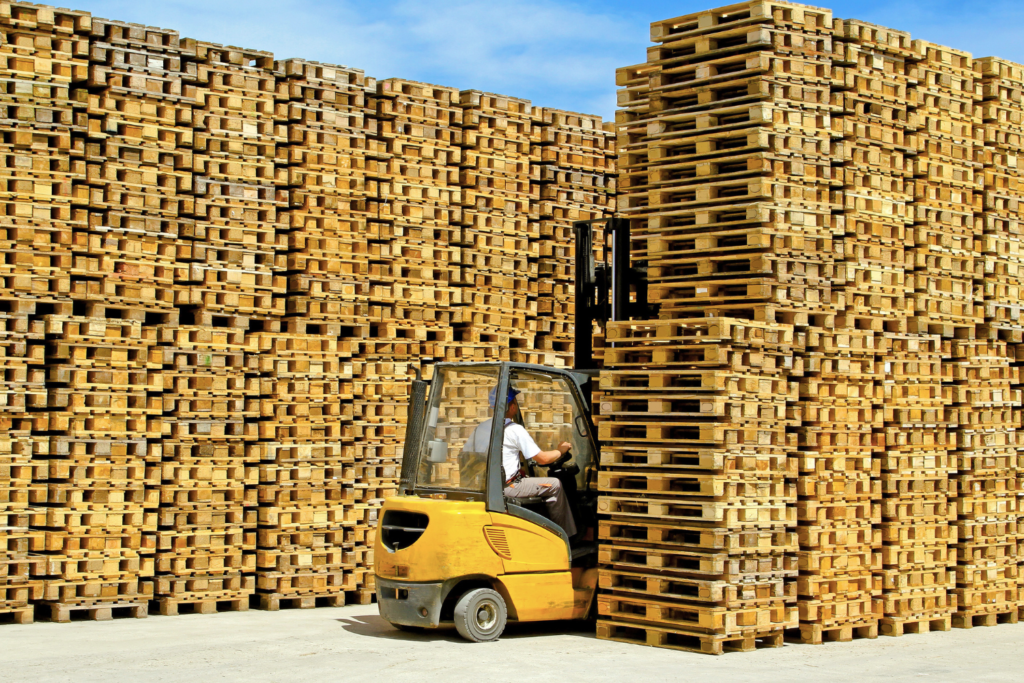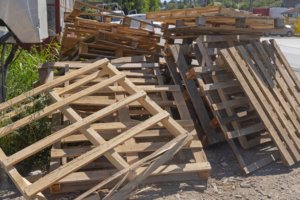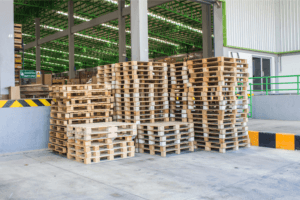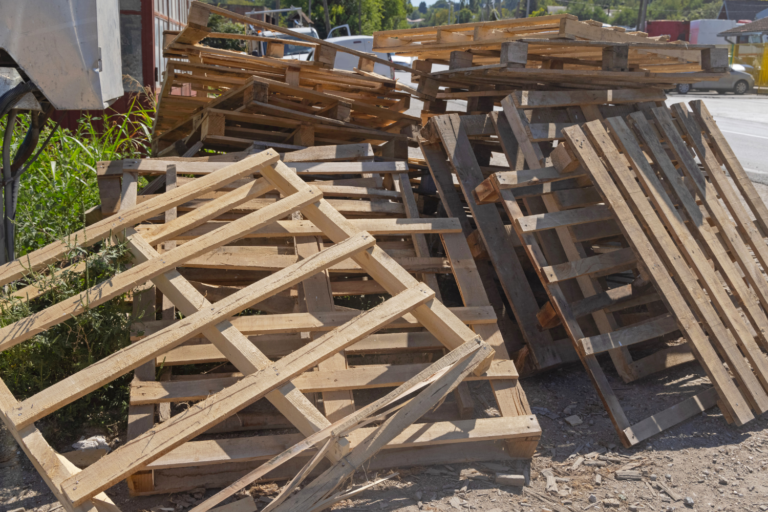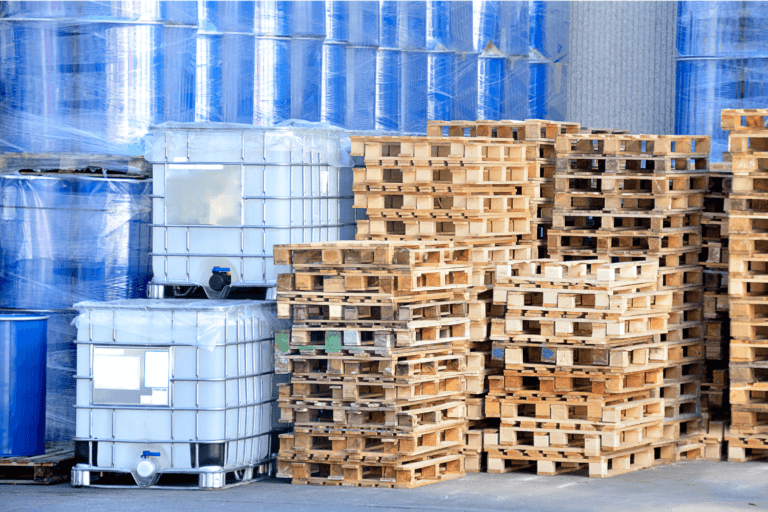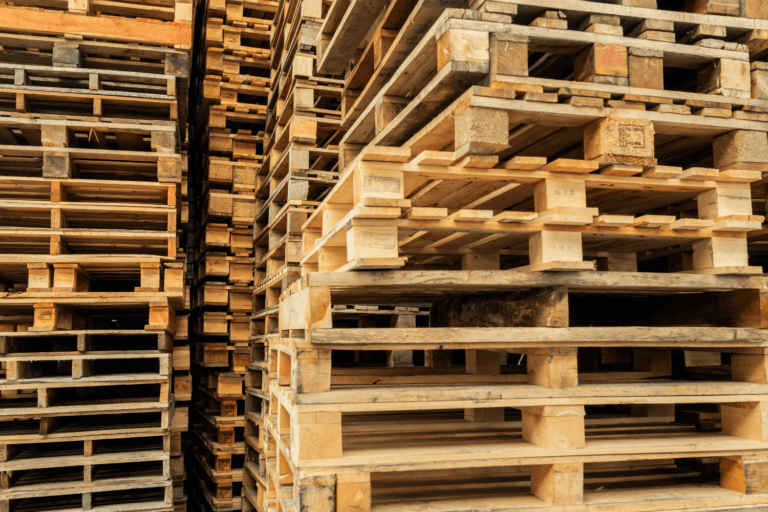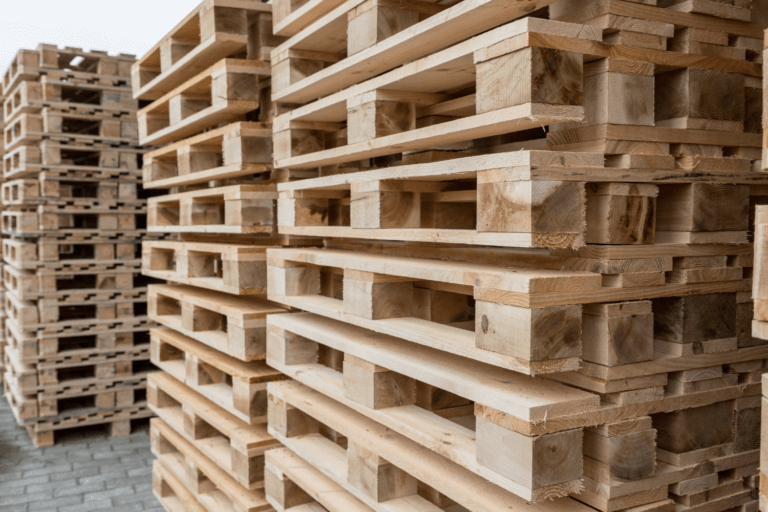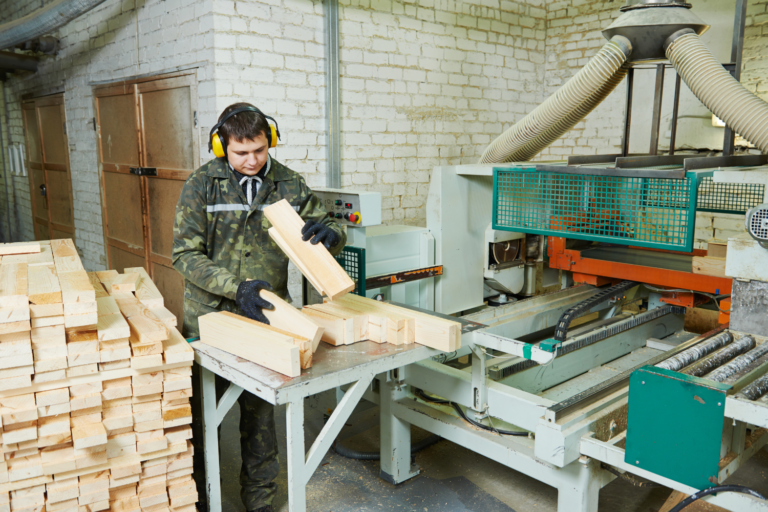Understanding the differences between GMA and block pallets enables you to select the pallet type that best aligns with your operational demands.
If you carefully consider factors such as load weight, storage conditions, handling requirements, and regulatory standards, you can optimize your pallet usage to improve efficiency.
Let us discuss GMA vs. block pallets.
What Are GMA Pallets?
GMA pallets are one of the most widely used pallet types in North America.
Designed according to standards set by the Grocery Manufacturers Association, they are commonly used in industries such as food, beverage, and consumer goods.
They typically measure 48” x 40” and are constructed with a wooden stringer design, featuring two parallel boards that run along the length of the pallet with deck boards nailed on top.
This allows for easy handling by forklifts and pallet jacks from two sides.
They are built to support uniform loads, so they are ideal for standardized packaging used in grocery distribution and retail supply chains.
Their widespread adoption is due to their compatibility with the warehousing, distribution, and transportation infrastructure commonly found in North America.
What Are Block Pallets?
Block pallets are known for their robust and versatile design, which typically features nine solid wood or plastic blocks as the main support structure.
The blocks are located at each corner, the middle edges, and the center.
This configuration allows forklifts and pallet jacks to access the pallet from all four sides, providing greater flexibility in handling and positioning during loading, storage, and transport.
They can be constructed with either wooden or plastic deck boards and are often used for heavy-duty applications due to their durability and ability to support higher weight capacities.
Their increased strength and versatility contribute to their popularity in global logistics, especially in regions like Europe, where they are commonly used.
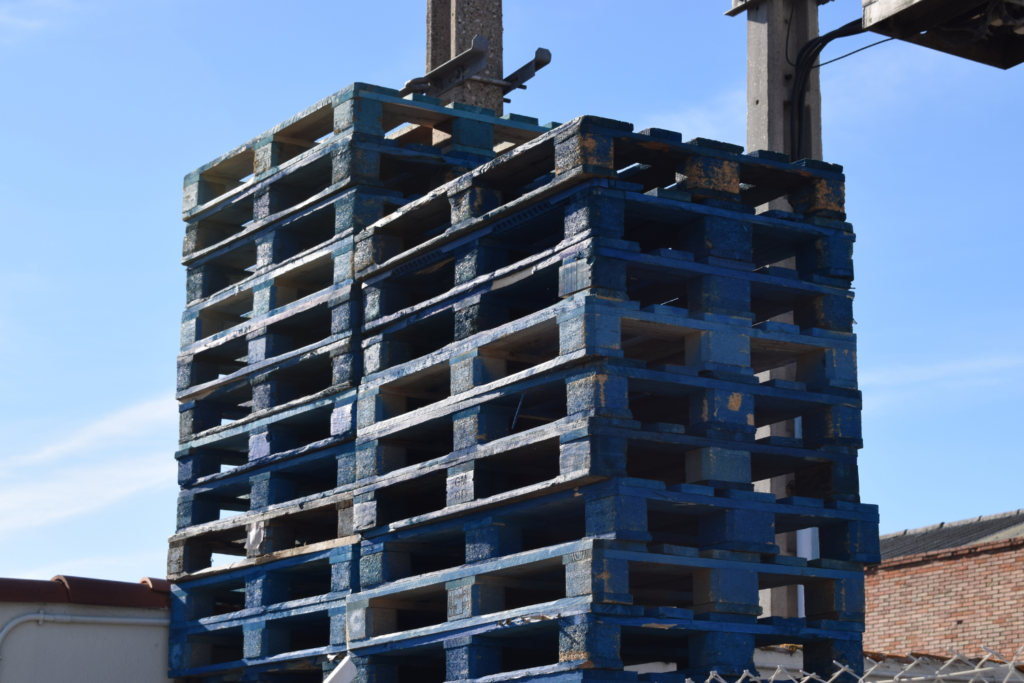
GMA vs. Block Pallets: What Are the Major Differences?
GMA pallets, with their cost advantage and standardization, are perfect for routine, light- to medium-load applications within controlled environments.
In contrast, block pallets, although more costly, provide superior strength and flexibility, making them indispensable for heavy-duty and high-value shipments.
Below are the major differences between GMA and block pallets.
1. GMA Pallets Are Considered the Standard in the United States
GMA pallets are widely regarded as the standard in the United States, especially in the grocery, retail, and consumer goods sectors.
Their simplicity and widespread availability will allow you to reduce costs and improve efficiency in logistics and warehousing.
2. Block Pallets Are Constructed with Stringers and Blocks
Block pallets are constructed with a combination of stringers and blocks.
This design uses nine blocks placed at each corner, along the sides, and in the center to provide a sturdier and more stable base for carrying heavy loads.
3. GMA Pallets Have Notched Stringers for Forklift Access
GMA pallets feature notched stringers to allow forklifts and pallet jacks to lift them from two sides.
The notches provide access for handling equipment, enabling easier movement in warehouses. The notched stringers of GMA pallets may suffice for lighter loads.
4. Block Pallets Can Be Made From Plastic and Metal
Unlike GMA pallets, which are predominantly made from wood, block pallets can be constructed from plastic or metal.
These alternative materials offer specific advantages, such as increased durability, resistance to moisture and chemicals, and compliance with hygiene standards.
Plastic block pallets are particularly valued in closed-loop supply chains where the pallets are reused many times, while metal block pallets are used in environments that demand extreme durability.
5. Block Pallets Are Reversible
Block pallets are often designed to be reversible, meaning they have identical top and bottom decks.
This reversibility provides an added level of functionality, as the pallet can be used with either side facing up, enhancing versatility in stacking and handling.
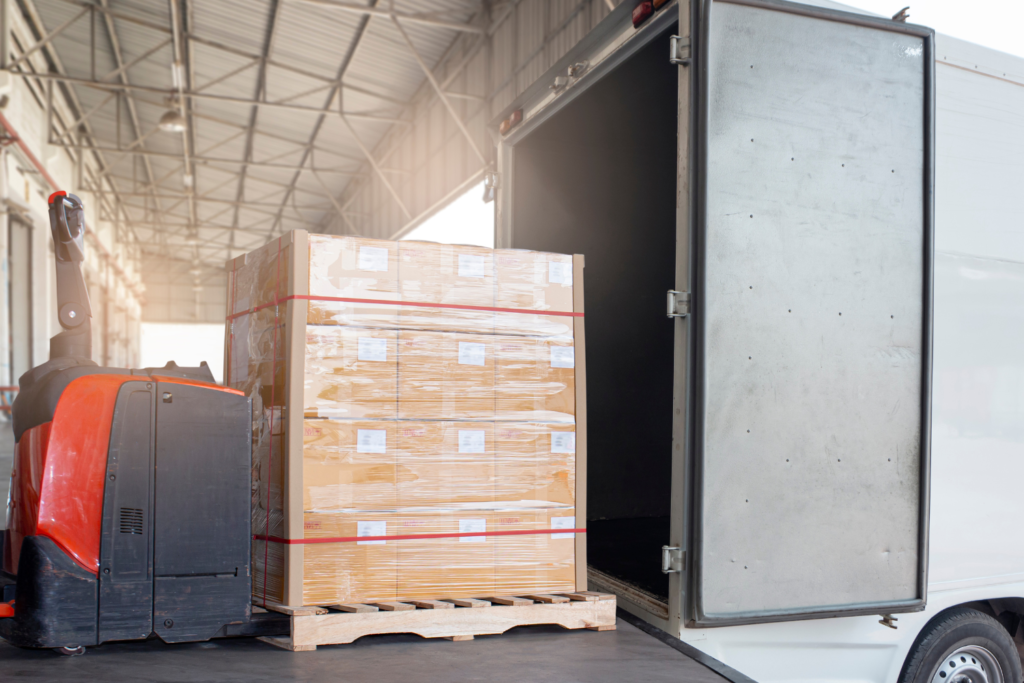
When Is It Best to Use GMA Pallets?
GMA pallets shine in large-scale distribution systems like those of retail giants or food distributors.
They offer standardized sizing and are cost-effective. Their compatibility with pallet exchange programs also adds a layer of convenience.
If your operations prioritize standardization, cost efficiency, and frequent handling of consumer goods, GMA pallets are your go-to solution.
When is it best to use GMA pallets? You can find the answers below.
1. There Are Automated Warehouse Systems in Place
GMA pallets are an ideal choice when automated warehouse systems are in place, as their standardized dimensions and consistent design are compatible with those.
The widespread use of these pallets across the United States ensures that they meet the specifications required for such systems, so you can expect minimal disruptions in material handling.
2. You Will Transport Lightweight Items
Using GMA pallets is advantageous when transporting lightweight items.
Their stringer construction is suitable for loads that don’t require the added durability or higher weight capacity of block pallets.
They can support typical packaging found in the food, beverage, and retail industries, where products are often standardized and relatively light.
3. You Need a Constant Supply of Pallets Year-Round
GMA pallets are the standard, so they are produced and distributed by many suppliers, ensuring a steady supply regardless of seasonal fluctuations in demand.
The ability to quickly procure them from multiple sources allows you to avoid delays and shortages, ensuring that your supply chain remains resilient.
4. You Are Required to Use GMA Pallets
In some cases, regulations or customer requirements may require the use of GMA pallets.
For example, certain retailers and distributors specify GMA pallets for all shipments to maintain uniformity in their logistics networks.
Using GMA pallets ensures compliance with these requirements, preventing any potential rejection of shipments due to non-standard pallet sizes.
Meeting such guidelines is crucial if you need to maintain relationships with large retailers or operate within industries that follow stringent standards for packaging and handling.

When Is It Best to Use Block Pallets?
Block pallets are at their best in tough environments where durability and load-bearing are crucial.
They are ideal for heavy-duty applications, such as in the automotive or construction industries, and can handle significant weights and rough handling.
Their four-way entry design also makes them a breeze to maneuver, perfect for fast-paced warehouses.
Here are the situations where you can use block pallets.
1. You Need Pallets Than Can Handle Heavy Loads
Block pallets are the preferred choice when there is a need to handle heavy loads due to their construction.
The use of blocks rather than stringers provides a stronger and more stable base, allowing them to support higher weight capacities.
They are perfect for manufacturing, automotive, and international shipping, where products are often heavy and require pallets that can withstand substantial weight.
2. You Want Reversible Pallets
Many block pallets feature identical top and bottom decks. This reversibility allows for more versatile usage, enabling the pallet to be used with either side facing up.
This added functionality offers greater flexibility in handling and ensures that the pallet remains a reliable solution regardless of how it is oriented during loading and transport.
3. You Are Required to Use Block Pallets
International shipping standards, for example, often favor block pallets because of their compatibility with global logistics infrastructure.
Some countries and regions, especially in Europe, follow guidelines that specify their use to ensure consistent pallet quality across borders.
Additionally, industries dealing with heavy machinery, chemicals, or high-value goods may require the superior durability that they provide to minimize the risk of damage during transit.

Conclusion
When deciding between GMA and block pallets, the choice often comes down to your specific needs, the nature of the products being shipped, and any applicable regulations or industry standards.
GMA pallets are a cost-effective option if you deal primarily with lightweight or standard-sized shipments.
On the other hand, block pallets provide a stronger, more versatile alternative for handling heavier loads or challenging conditions.
We are a distributor of GMA and block pallets. Once you have decided which type you will use, contact us so that we can give you a quote.
Chesapeake Pallets has been helping companies across the United States level up their logistics, one pallet at a time.
For inquiries, email info@chesapeakepallets.com or request a quote below!

